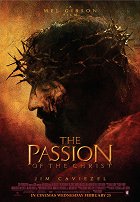Rendező:
Mel GibsonForgatókönyvíró:
Mel GibsonOperatőr:
Caleb DeschanelSzereplők:
James Caviezel, Maia Morgenstern, Hristo Jivkov, Francesco De Vito, Monica Bellucci, Mattia Sbragia, Toni Bertorelli, Luca Lionello, Hristo Shopov (több)Tartalmak(1)
A passió című film Názáreti Jézus életének utolsó tizenkét óráját jeleníti meg. A film nyitójelenete az Olajfák hegyének lábánál, a Gecsemáné-kertben játszódik, ahová Jézus elvonul az Utolsó Vacsora után imádkozni. Jézus ellenáll a Sátán kísértésének. Iskarióti Júdás árulása miatt Jézust elfogják és visszaviszik Jeruzsálem város falain belülre, ahol a farizeusok istenkáromlás vádjával szembesítik és tárgyalása halálos ítélettel végződik. Jézust Pilátus, Palesztina római kormányzója elé vezetik, aki meghallgatja a farizeusok ellene szóló vádjait. Felismervén, hogy politikai konfliktussal került szembe, Pilátus Heródesnek engedi át az ügyet. Heródes visszaküldi Jézust Pilátushoz, aki Jézus vagy Barabás, a bűnöző közötti választás elé állítja a tömeget. A tömeg Barabás szabadulása és Jézus elítélése mellett dönt... Jézusnak átadják a keresztet és utasítják, hogy vigye végig Jeruzsálem utcáin, fel a Golgotára. A Golgota hegyén Jézust a keresztre szegezik és szembesülnie kell az utolsó kísértéssel: a félelemmel, hogy Atyja elhagyta. Sikerül leküzdenie a félelmet, Máriára, Szent Anyjára tekint és kimondja a szavakat, amelyeket csak ő érthet meg egészen: "Elvégeztetett." Aztán meghal: "A kezedbe ajánlom lelkemet." - hangzik el. Halálának pillanatában a természet is gyászol: "a föld megindul, a kősziklák repedeznek". (Budapest Film)
(több)Videók (1)
Recenziók (7)
A Passió egy bensőséges, szinte színházi film, lélegzetelállító nagyvásznas koncepcióval. A film lényege nem a hatalmas történelmi díszlet, hanem a tökéletesen felvett jelenetek hatása, amelyek - akár beltéren, akár kültéren - csak pár négyzetméternyi területen játszódnak. A film azzal a jelenettel kezdődik, amelyben "egy kétségbeesett fiatalembert" üldöznek, majd a meglincselésével folytatódik, és a halálával végződik. Hogy ki rejtőzik a csuklya alatt, és ki a többi arc a képernyőn, azt csak a kínzása közbeni rövid flashbackekből tudjuk meg. Személyazonosságuk felfedése elmélyíti kapcsolatunkat a názáreti Jézussal, és egyben átérezzük a fájdalmukat is. A film ereje abban rejlik, hogy egy nagy szívű ember leírhatatlan szenvedését mutatja be, amelyet a szív nélküli emberek okoznak. ___ Mel Gibson a történetmesélés őszinte útját választja, az érzelgősség legkisebb jele nélkül. Pártatlan marad, és szó szerint élvezi, hogy meglincselheti az embert. Lassított felvételen, a szenvedő egyre fokozódó fájdalmában egyformán érezteti velünk a fizikai fájdalmát és a hóhérok szadista ösztöneinek kegyetlenségét. Ez a megdöbbentően hűvös indulás az első harmadban odaszegez minket a székbe, hogy aztán később Jézus spirituális mondásainak visszatekintéseivel elmélyítse az egész borzalmat, értelmet, érzelmeket és filozófiai dimenziót adva neki. A mártír és hóhérai egyre erőteljesebben testesítik meg a jó és a rossz értékeit, és együtt olyan "művet" hoznak létre, amely örökre megváltoztatja az emberi történelmet. ___ A film lassú tempóban halad, és több mint két órán át tart, de nem találunk benne egyetlen olyan felvételt, hangot sem vágást, amelynek ne lenne meg a helye, és ne váltaná ki a szükséges érzelmeket. Hipnotikusan folyékony, komor vers, amely hatalmas, percről percre mélyülő sürgősség súlyát viseli a hátán. Vagy nem nézel oda, vagy visszatartod a lélegzeted, vagy elgondolkodsz az elhangzottakon.
()
No hyperactivity turning to faith and as a result fortunately no exaggerated controversy. The crucifixion is brutal and cruel, but also impressive, touching, and surprisingly grand. Its fascinating atmosphere drew me in despite some prejudices, and I am glad that ten years after its creation, Gibson's opus is finally receiving positive reviews. This film is definitely not easy to love, but it is quite easy to be amazed by it.
()
Those brutal scenes that everyone take dso much about weren't really that terrible. Rather than being naturalistic, they were just very bloody. In terms of craftsmanship, it is again precise, but that is not new for Mel Gibson. As for the content, there is nothing left but to describe it as controversial. The music is breathtaking.
()
I find this film hard to rate, even after a second viewing. If I were to rate only the major part of the film that precedes the journey to Golgotha, it would be 5 stars. Brilliantly played Pilate, Herod is an outright treat despite the small space and Mattia Sbragia is very convincing as the resolute Caiaphas. I really enjoyed the scenes of Pilate and Jesus together. The much criticized flashbacks are impressive and especially the one with Mary and Jesus at the table is really beautiful and full of emotions. But starting with The Road to Golgotha, Gibson's film loses its impact. Gibson made Christ a being who, by superhumanly overcoming all the immense hardships, seems implausible. I would argue that less is sometimes more, that a few slashes to the skin would be more painful and real than all those cuts covered in blood on something that used to resemble a human body. As a result, Christ’s suffering loses its human dimension. Also, the scene when a raven pecks out the eye of one of the crucified thieves has no support in the Gospels and smacks strongly of gratuitousness. Yet, I have to admit that the film has a certain amount of power, multiplied by the visit to the cinema, where everyone sat until the end credits finished rolling, which I haven't experienced for a long time. As an afterthought, I acknowledge that my original criticism about the total lack of ideas, and that it doesn't even come close to Scorsese's The Last Temptation of Christ is perhaps a bit off the mark. This film is not supposed to explain anything, to introduce characters in a clear way so that average viewers can understand. Perhaps the renowned Roger Ebert wrote it most succinctly: "This is not a sermon or a homily, but a visualization of the central event in the Christian religion. Take it or leave it.” But the question remains, is this film necessary? Gibson's artistic statement is ideally suited to a time when, thanks to the permanent threat of terrorism, the world is exposed to a clash of civilizations, a clash of religious principles, and the huge success of the film in the US can be attributed to the need for ideological refuge. And history repeats itself in cycles. The clashes among the Abrahamic religions – Judaism, Christianity and Islam – have and will continue to cause much blood and suffering. And it's not so much a problem of religion itself, but rather of the animal species called homo sapiens stupidus, which has a coded need for fight and cruelty, which is very clear in several scenes in Gibson's film. Let that be to his credit.
()
A standard large-scale film production, baroque rigid faces of the actors, an attempt at distinctive artistic stylization, self-purpose escalated brutality, excellent soundtrack.... And all this is in the service of the sacred purpose of the film. Mel Gibson and Benedict Fitzgerald have chosen a very simple script trick, wherein they put reminiscences of the long-suffering and hardship of Jesus Christ in convenient places on familiar gospel scenes to reinforce the film's message. A message that I personally consider to be the most problematic part of a newly born phenomenon. This phenomenon speaks precisely to the part of the audience that is knowledgeable about biblical themes. It speaks in a way that is not dialogical, but purely illustrative. Here is the hero, this is what the evil Pharisees and the gloating people of Jerusalem did to him, and now you must feel indebted to him. Who Christ was, what is his message to the world — that is what The Passion of the Christ deals with very sketchily. It's not a testimony, but rather just a bloody portrayal of one of the greatest stories in human history. The biggest and most impressive. Mel Gibson actually gave the best testimony of the state of contemporary American cinema. The viewer is no more than sitting and staring while the "narrator" thinks for him. No one asks you to think, ask, or interpret during the film; even the strongest — that is, Christ's struggle with doubts about his mission — must be thematized into an embarrassingly literal character of the devil. Your only mission is to monitor the flow of carefully chewed and thoughtful "pseudo-reality", which has completely lost its symbolic validity and becomes a bloodthirsty direct transmission from the greatest execution of antiquity. And so, as the blood squirted into the orchestra, the makeup-smeared James Caviezel soiled the ground with artificial raspberry juice and made throaty sounds, I remembered a medieval liturgical drama where the same story is depicted with perspective and human kindness – loosely, playfully, with imagination, and it was a hundred times more impressive. Because while this is a celebration of human life, Gibson's "masterpiece" is merely a deafening invocation of deified death. Or: a "media event" once again triumphed over artistic quality... Not as bad or as good a film as some say.
()



Hirdetés